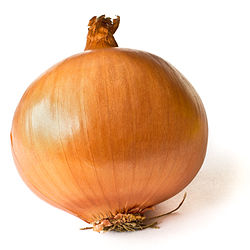| Yellow onion | |
|---|---|
 Yellow Onion | |
| Genus | Allium |
| Species | Allium cepa |
The yellow onion or brown onion ( Allium cepa L. [1] [2] ) is a variety of dry onion with a strong flavour. They have a greenish-white, [3] light yellow, [4] or white inside; [5] its layers of papery skin have a yellow-brown or pale golden colour. [3] [4]
It is higher in sulphur content than the white onion, which gives it a stronger, more complex flavour. [5] [6]
A dozen varieties of yellow onion are grown, following the time of year. They vary in nutritional content, but they do contain quercetin (a flavonol). [1]
Yellow onions are typically available throughout the year, [4] grown between spring and fall, and then stored for the rest of the year. [4] It is the most commonly grown onion in northern Europe, [2] and it makes up 90% of onions grown in the United States. [4] They should be stored at cool room temperature in a dark place. Longer-term storage requires them to be wrapped in paper and placed in a refrigerator. Cut or peeled onions also need to be stored in plastic in the refrigerator, but they will last only a few days. [4]
They have a rich onion taste and are fit for dishes such as French onion soup, other soups, stews and braises, sautéed dishes, and shish kebabs. [5] They can become sticky and sweet when caramelized. [4]